#matchbox factory in india
Text
Volatile History of The Bangladesh Textile Industry

The Dhaka Muslin
In this article you would learn about the history and current scenario of the 2nd largest textile manufacturer in the world which is Bangladesh. Let’s start with the history, Bangladesh is not a new player when we talk about textile industry. It has a long history of manufacturing textile items. When we talk about 1000 years back. Bangladesh textile industry used to manufacture a special fabric called Dhaka Muslin. The speciality of this fabric was that it was very thin, it was so thin that 50 meter long fabric could be stored in 1 matchbox. This fabric was the choice of the royal families. Even Napoleon's wife used to wear clothes made out of this fabric.
The Fall of Bangladesh Textile Industry
Bangladesh used to export cotton and silk between the 16th to 18th century. The countries to which exports were done were EU, Japan and Indonesia. It was an important place for the mughal emperor because of the exports. In 1757 britishers colonized Bangladesh which led to deindustrialization of textile industry. They used to import their product to Bangladesh and stopped exporting Bangladesh finished product to any country.
Situation of Bangladesh Textile Industry Post Independence
In Bangladesh there was major influence of west Pakistan post 1947, as they used to own major textile factories in Bangladesh till 1971. In the 1960s some native opened their textile factories. After the independence of Bangladesh there was an industrial enterprise order act passed by Sheikh Mujibur Rahaman. According to this act all the privately owned textile factories came under government control under the name Bangladesh Textile Mill Corporations.
These public owned factories were not performing well and after 1975 it started making losses, because of these losses the factories were given back to their prior owners in 1980. After that we have seen an upward direction of growth in the textile industry in Bangladesh. Today they have surpassed the growth of the textile industry in India. In today’s time many global buyers buy t-shirts in bulk, trousers, jeans, shirts and tops from Bangladesh.
#bangladesh#textile industry#textile#textiles#small business#business#entrepreneur#manufacturing#manufacturer#political#exports#exporter#apparel#garment#garment industry#clothing#clothes#dyeing#knitting#yarn#fiber art#pattern
0 notes
Text
Matchbox Exporting Company in India
In the heart of Madurai, a city steeped in tradition and craftsmanship, emerges BglobalIndia as the epitome of quality and innovation in matchbox manufacturing and exporting. As the premier Matchbox Exporting Company in India, we take pride in our commitment to excellence, sustainability, and client satisfaction.
Established in Madurai, BglobalIndia has carved a niche for itself as a trailblazer in the matchbox industry. Our journey is a testament to the fusion of tradition and modernity, creating matchbox products that stand out for their precision, reliability, and aesthetic appeal. With years of experience, we have honed our craft to become synonymous with unmatched quality and innovation.
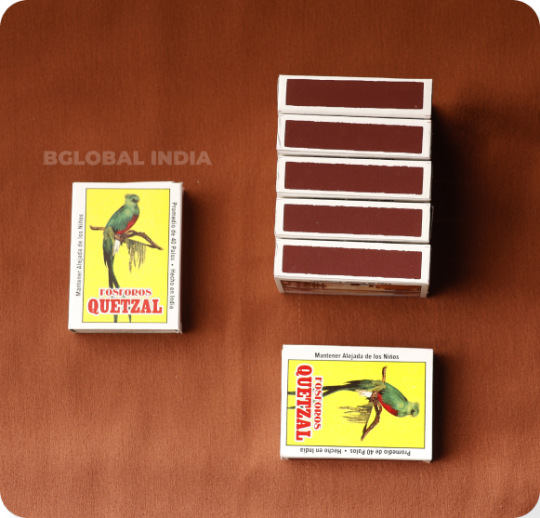
BglobalIndia proudly wears the title of the best Matchbox Exporting Company in India. Our global reach spans across continents, delivering our superior matchbox products to clients worldwide. Despite our international presence, we maintain a deep connection with our roots in Madurai. Our local expertise allows us to understand the unique preferences and requirements of diverse markets, giving us a competitive edge in the global arena.
One of the hallmarks of BglobalIndia is our unwavering commitment to innovation. We constantly push boundaries and explore new avenues to enhance our products. Our team of skilled designers and engineers collaborates to bring forth matchbox designs that are not only functional but also visually appealing. We understand that customization is key, and our flexible approach ensures that we cater to the unique needs of each client.

As a responsible Matchbox Exporting Company, BglobalIndia places a strong emphasis on sustainability. We are mindful of our environmental impact and actively pursue eco-friendly materials and production processes. From sourcing raw materials to packaging, we strive to minimize our carbon footprint and contribute to a greener, more sustainable future.
In the world of international trade, timeliness is of the essence. BglobalIndia has earned a reputation for prompt and reliable deliveries, ensuring that our clients receive their orders on schedule. Our commitment to competitive pricing further sets us apart, offering unmatched value without compromising on quality.

Behind the success of BglobalIndia is a dedicated team of experts who bring passion and expertise to every aspect of our operations. From skilled craftsmen on the factory floor to our dynamic sales and customer service teams, every member plays a crucial role in maintaining the high standards that define our brand.
At BglobalIndia, client satisfaction is not just a goal; it's a commitment. We prioritize open communication, understanding our clients' needs, and providing solutions that exceed expectations. Our client-centric approach has led to enduring partnerships, making us the trusted choice for those seeking the best in matchbox exports from India.
0 notes
Text
Child labour
Child Labour means the employment of children in any kind of work that hampers their physical and mental development, deprives them of their basic educational and recreational requirements. A large number of children are compelled to work in various hazardous and non-hazardous activities such as in the agriculture sector, glass factories, carpet industry, brass industries, matchbox factories, and as domestic help. It is a blot on our society and speaks immensely about the inability of our society to provide a congenial environment for the growth and development of children.
Childhood is considered to be the best time of one’s life but unfortunately, this does not hold true for some children who struggle to make both ends meet during their childhood years. According to the Child Labour project and 2011 census, 10.2 million children are engaged in child labour in India, out of which 4.5 million are girls.
Earlier, children helped their parents in basic chores in agriculture such as sowing, reaping, harvesting, taking care of the cattle, etc. However, with the growth of the industries and urbanization, the issue of child labour has increased. Children at a very tender age are employed for various inappropriate activities and they are forced to make hazardous stuff using their nimble fingers. They are employed in the garment factories, leather, jewellery, and sericulture industries.
0 notes
Photo

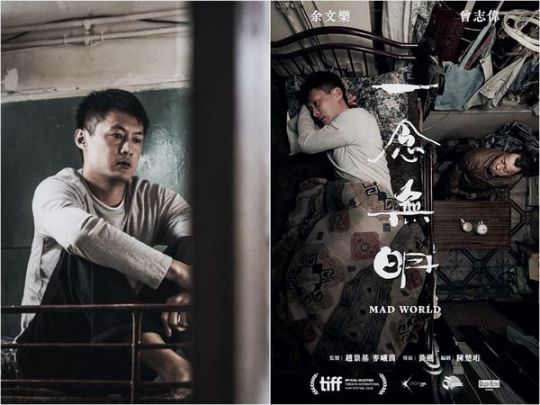



5 GREAT ASIAN FILMS ABOUT POVERTY & SOCIAL INJUSTICE―MUST-WATCH LIST
Grave poverty and social injustice are now a threat to human progress and stability everywhere in the world.
Pope Francis said correctly, “Globalization has helped many people rise out of poverty, but it has also damned many others to starve. It is true that wealth is growing in absolute terms, but inequalities have also grown and new poverty arisen. We cannot wait any longer to deal with the structural cases of poverty in order to heal our society from an illness that can only lead to new crises. We need projects, mechanisms and processes to implement better distribution of resources, from the creation of new jobs to the integral promotion of those who are excluded.”
Worst of all, some rich people regard poverty as a shame and being ashamed of it by the poor themselves makes the problem more disturbing.
In many places, violence is seen as a more efficient means than non-violence in redressing the injustice. In fact, violence cannot. Violence drives out peace and stability, the reliable platform on which all sides can talk and solve. We shall not be captured by the moments of emotion and let the society be hijacked by the extremists. It is dangerous to let hate and violence to drive a society to a corner where everyone feels insecure and fearful. We must not expel hopes and talks, and we must affirm the positive value of communication.
Some used to think art is to serve the rich. It is not. Modern artists also have a social conscience. Some want, in order to send a warning signal to the world, to portray poverty and its hardships. The urban poor, jobless, ragged, senile, sick, heartbroken and hopeless are all good objects and topics for an artist. Contemporaries are motivated by the mix of curiosity, compassion, anger and sympathy which drew the artists to presenting the brutal realities of poverty. Our world is changing fast and more high-tech. It however has not done enough for the poor. The expressions and protests against poverty and social injustice through art are far more powerful than physical violence which can bring a society to the edge of a cliff next to the ocean of anarchy.
In recent times, Korea, Japan, Taiwan, China Mainland and Hong Kong, the 5 ‘chopsticks-using’ places, all produced an outstanding film related to poverty. Such films received numerous awards in international film festivals and the Japanese and Korean ones got even the crown jewel in Festival de Cannes.
Parasite is a 2019 South Korea dark comedy - drama film directed by Bong Joon-ho. A driver and his wife were unemployed. The two teenager kids had no money to go to college. The family struggled to survive by folding pizza boxes in their semi-basement home. Being desperate, they invented a plot to take advantage of a rich family. Initial ‘parasiting’ on the target family turned out to be successful. The poor became more aggressive with regard to their plan B of sucking up the rich family.
In 2018, Japanese director Hirokazu Koreeda made a film called Shoplifters. At first blush, there is nothing irregular about a poor family in Tokyo: there is a man and his wife, a little boy, a sweet girl, an older sister and an old granny, all living in a tumbledown bungalow covered with dust and dirt. It is shocking to discover that the food and necessities of the family were all trophies of their shoplifting. It is even more shocking to later realize that the family relationships were made up in order to cheat the outside world. How could this horrible family carry on when the others started to eye the members with suspicion?
The 2017 Taiwanese film directed by Huang Hsin-yao, The Great Buddha+, won more than 20 awards. Pickle was a night security guard at a bronze buddha factory. His friend Belly Button was a scavenger. They were poor and abandoned by the society. Having late night snacks, enjoying porn magazines picked up from trash bins and watching television were their dull daily life. One day when the television did not work, their life was changed completely after they found something to replace the television. That ‘something’ was the beginning of a murder story.
Dying to Survive is a 2018 Chinese film directed by Wen Muye and it is his feature film debut. The film is based on the real-life story of a lower-class businessman who smuggled cheap but unproven cancer medicine from India for the thousands of cancer sufferers in China in 2004. He started out importing the illegal drug to make good money, but he came to feel how much it mattered to his dying customers. His smuggling gang included a weird middle-aged man, a rebellious teenage, a stubborn priest and a pole dance lady who were exhausted by poverty. Money soon shattered their unity and caused the parties an impossible situation.
Finally, it is Hong Kong. Mad World is a 2016 tragedy directed by Wong Chun. Tung, a patient having bipolar disorder, was discharged after serving the sentence of manslaughtering his mother. He was placed in the custody of his truck-driver father who belonged to the ‘working poor’ class. They lived in a tiny and smelly ‘matchbox’ room in dilapidated condition. The neighbours were hostile to such a dangerous intruder and they decided to do nasty things against the poor family.
The above 5 poverty films are artistically sublime and stimulating. They depicted how poverty had become a punishment on the unfortunate for a crime that they did not commit in these Asian cities which look gorgeous from the outside. The 5 films strike a fine balance between artistic and commercial elements. You should not miss such great films. I do not know if poverty is a necessary accompaniment to civilization or not. I do know that without poverty and social injustice, the artists like film directors would not have been able to be inspired by the misery of the sad and poor; and to use their unhappiness to tell how happy some of us are.
【Shoplifters: https://youtu.be/zm3pXxgjyJw】
【Parasite: https://youtu.be/hb1iOVvkykY】
【Mad World: https://youtu.be/MfGDc-LOmNE】
【The Great Buddha+: https://youtu.be/br7eRYniQ90】
【Dying to Survive: https://youtu.be/tVGjPgpbmYg】
#Pope Francis#Parasite#Shoplifters#The Great Buddha+#Dying to Survive#Mad World#Urban Poor#Working Poor
24 notes
·
View notes
Text
Matchbox exporting company in India
Matchbox exporting company in India
Geewin matches are the prominent safety matches manufacturers in TamilNadu, India. Moreover, the company motto is to create the best quality matches at a reasonable cost. And also, we are leading wholesaler and exporter of safety matches all over the world especially in Africa, Canada, Nigeria, and Caribbean countries. In detail, our high-quality products are cardboard safety matches, kitchen…
View On WordPress
#match box manufacturer#match stick production#matchbox factory in india#matchstick manufacturing company#safety match box manufacturer#safety matches exporters#safety matches manufacturer#safety matches manufacturing factory.#safety matches wholesaler company#safety matches wholesalers company
0 notes
Text
Tips to begin a rural business
Atma Nirbhar Bharat, the thought spread and upheld by the Government is tied in with turning out to be in fact and monetarily confident. It supports the trendy business people to face a challenge and become decisive in their way to deal with breaking the unfair limitation. The public authority's drive isn't selective to enormous city business people however has widespread allure and is additionally implied for humble community/town level business visionaries. Also check out rural tech company in India.
With over 70% of the populace dwelling in towns and humble communities, the chances to begin new organizations is more there. As the greater part of the organizations in the rustic hinterland are straightforwardly or by implication reliant upon farming or a connected area, there are various freedoms accessible to investigate and thrive with time. A portion of the business thoughts that can be investigated in the humble communities are talked about underneath for business people to accept a call. Click here for more info Ruraltech Startup.
A portion of the business thoughts for trendy business visionaries in humble communities/towns are:
Retail location
With most of the populace dwelling in rustic India, there is a lack of all around arranged retail outlets in these stamped regions. The power source can be of various sorts that take into account an alternate part of the populace. One such choice that is extremely simple and common sense is opening a Kirana store.
The Covid emergency has demonstrated the versatility of the Kirana retailers and the flexibility to learn and change as indicated by the new situation. It is an entirely achievable choice and is never out of interest given the Kirana store is opened at the perfect locations, has great client support and is very much supplied (production network). Different shops that can be opened in the country hinterland are:
Sweet shops
Tailor shop
Hardware shop
Cantina shop
Beauty care products shop
Bike/four wheeler specialist
Natural product shop/juice shop
Television/Radio/Mobile repairman
Electrical/handyman shop
Prior to opening the previously mentioned shops, it is important to have a specific degree of ability. It is important to have a few abilities and information to open the shop. Nonetheless, one advantage of opening a retail outlet is, it requires less of an ideal opportunity to begin the business and there is instant interest for such basics at each spot. For great tips click here Best Ruraltech Company.
Flour plant
Another thought that can merit investigating is the foundation of a flour plant. In provincial regions there is no scarcity of crude material(cereal) for the flour plants, additionally, individuals don't buy the pressed flour from the business sectors as apparent in metropolitan regions. It is an entirely plausible and beneficial business on the off chance that you grind different grains alongside wheat like corn, oats, grain, sorghum, and flavors like turmeric, bean stew, and so on
The flour factory can likewise supply the items to local urban areas and towns at a benefit. It is a decent business and requires restricted cash yet a decent electrical association with start and maintain the business. To know more click here rural fintech.
Limited scope fabricating units
Rustic regions and unassuming communities are ideal areas to begin limited scope fabricating units to take into account the interest in the neighborhood as well as providing items to local towns and urban areas. These assembling units can be for different items like:
Agarbatti
Flame/matchbox
Paper cup/paper plate
Bundling items
Expendable packs, and so forth
These items have a huge market in metropolitan regions, while the natural substance is in wealth in rustic regions to turn into a beneficial business with fast returns.
Clothing store
Going to enormous urban areas for purchasing garments on extraordinary events or for day by day needs is exceptionally normal in towns. Beginning a clothing store with great brands, textures, and assortment is a certain short way to progress given the proprietor has great contacts from the articles of clothing providers and the production network is flawless.
On the off chance that you can give the most stylish trends, plan, and style of garments, there will be a decent interest for the items in the towns and unassuming communities. You can likewise orchestrate fitting administrations and give handmade items to the customers at the store.
Poultry/live-stock cultivating
Poultry cultivating business is developing at a quick speed with dynamic help from the public authority offices. Besides, it isn't capital intensive and doesn't need a lot of land. Notwithstanding, an individual should have some experience to maintain the business. There is a tremendous interest for poultry items in country and metropolitan regions that assist in lessening the profit from speculation. At first, you can begin with a predetermined number of birds and furthermore the quality and assortment of birds, and with time can build the business. Alongside the nearby interest, you can publicize and sell the meat/eggs in urban communities.
0 notes
Link
The coronavirus pandemic is forcing India’s children out of school and into farms and factories to work, worsening a child-labour problem that was already one of the most dire in the world.
Sixteen-year-old Maheshwari Munkalapally and her 15-year-old sister stopped attending lessons when virtually the entire economy was brought to a halt during the world’s biggest lockdown. Munkalapally’s mother and older sister lost their jobs as housemaids in Hyderabad, the capital of the southern Indian state of Telangana. The younger girls, who had been living with their grandmother in a nearby village, were forced to become farmhands along with their mother, in order to survive.
“Working under the sun was difficult as we were never used to it,” Munkalapally said. “But we have to work at least to buy rice and other groceries.”
It’s difficult to quantify the number of children affected since the pandemic erupted, but civil society groups are rescuing more of them from forced labour and warn that many others are being compelled to work in cities because of the migrant labour shortage there.
Even before the outbreak, India was struggling to keep children in school. A 2018 study by DHL International GmBH estimated that more than 56 million children were out of school in India -- more than double the combined number across Bangladesh, Indonesia, Malaysia, Philippines, Thailand and Vietnam. The cost to India’s economy, in terms of lost productivity, was projected at $6.79 billion, or 0.3% of gross domestic product.
Of those children not in school, 10.1 million are working, either as a ‘main worker’ or as a ‘marginal worker,’ according to the International Labour Organization.
Global Trend
Global child labour had been gradually declining in the past two decades, but the Covid-19 pandemic threatens to reverse that trend, according to the ILO. As many as 60 million people are expected to fall into poverty this year alone, and that inevitably drives families to send children out to work. A joint report by the ILO and United Nations Children’s Fund estimates that a 1 percentage point rise in poverty leads to at least a 0.7 percentage point increase in child labour.
Indonesia, the world’s fourth most-populous nation, is another country that will see large numbers of children from vulnerable families drop out of school and into the workforce. The ILO estimates about 11 million are at risk of being exploited as child labourers under current conditions, especially in the less-developed eastern parts of the country, like Sulawesi islands, Nusa Tenggara and Papua.
Economic Loss
In India, home to more young people than any other country in the world, this lost generation of children will have substantial effects on Asia’s third-largest economy: lower productivity and earning potential, unrealized tax revenue, increased poverty levels and pressure for more government handouts.
“Even prior to the pandemic, numbers of children out of school in India and in child labour were high,” said Ramya Subrahmanian, the chief of research on child rights and protection at Unicef-Innocenti in Florence, Italy. “An even bigger issue will be for those children who are due to enter school during this time. If these children face delays in entering school, there may be an increase in the numbers of never-enrolled children, which could in turn push up child labour numbers.”
ALSO READ: ILO hails 'historic first' global convention to combat child labour
The Indian constitution provides free and compulsory education for all children in the age group of six to 14 years as a fundamental right. While Munkalapally and her sister are no longer covered by it because of their age, they are protected by the local law on child labour, which prohibits employment of adolescents between the age of 14 and 18 from working in any hazardous or dangerous occupations. The same law bars children under the age of 14 in any form of occupation except as a child artist, or in a family business.
Forced labour
“At a household level, it’s hard to differentiate whether children are involved or not,” says Dheeraj, a program manager at Praxis: Institute for Participatory Practices, who uses only one name. The jobs may still be hazardous and against the law -- small-scale businesses such as matchbox-making can be run from home -- but the difficulty in identifying such labour leaves children open to exploitation.
Bonded labour, where people are forced to work for creditors to pay off their loans, is another avenue where families send their children to work.
A total of 591 children were rescued from forced work and bonded labour from different parts of India during the lockdown by Bachpan Bachao Andolan, a civil society group on children’s rights, founded by Nobel laureate Kailash Satyarthi.
“Once the lockdown is lifted and normal manufacturing activity resumes, factory owners will look to cover their financial losses by employing cheap labour,” the group said in a statement.
NGOs point to the fact that the real spike in child labour is yet to come. When economic activity begins accelerating, there is a risk of returning migrants taking children along with them to the cities.
“When hotels reopen, construction work starts, the railways get back on track, when everything opens up, this community that has returned will be the main source that take our children to the cities,” said Abhishek Kumar, program coordinator at SOS Children’s Villages.
ALSO READ: Lockdown has hurt education of 247 mn school kids in India: UNICEF report
Children may be seen as a stop-gap measure to fill jobs left vacant by migrant labourers who fled cities for their rural homes during the lockdown.
“The burden has shifted to the poor households within urban areas,” said Rahul Sapkal, an assistant professor at the Centre for Labour Studies in the Tata Institute of Social Sciences in Mumbai.
While children aren’t exactly engaging in heavy labour usually carried out by adults, if parents take their children along for support in their jobs, even if it’s to avoid leaving them at home, a precedent is set, and such activity is normalized, he said.
Mukalapally mother, Venkatamma, is unhappy that her children are now forced to work, but cannot think of any alternative. The money they make is still not enough.
“Vegetables, rice, spices, soap, we still cannot afford these despite the four of us working,” she says. “It would be better if we could go back. In Hyderabad, even if the work is difficult, the pay is better.”
0 notes
Text
Week 15- Final approvals and Adrishya Hath’s 1st shoot
In this week... We had everything finalised with all the documents and necessities intact to avoid any issues on our shoot.
I and my team commuted to the factory for the location check, look-test and screen-test.

Look test and screen test was nerve-wracking, it was the first time we met our actors moreover the first time I actually got a hang of my role. I was with the actors helping them speak their dialogue and handle their costume, makeup, hairstyle, exactly how our team visioned want it captured. I am lucky to have a supportive team to calm me during tension and stress.
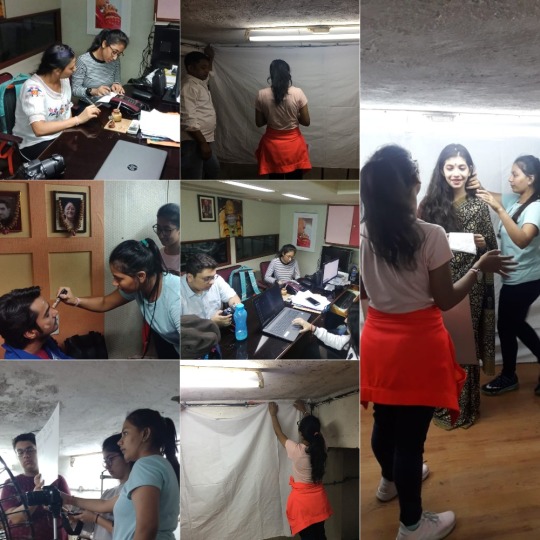
Before the actors appeared I had my myself setting the room for the screentest along with Keyosha while Vedant helped Janhavi with camera and tripod setting. Once we were ready to begin,I solely was with helping the actors get in costume and mood in a different than where my team was conducting the tests this occurred due to limited space however I was in constant contact with my members.
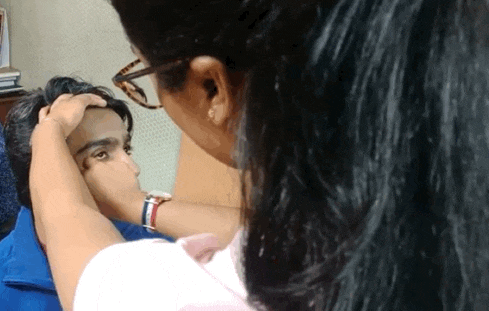
We were all pumped up and excited (slightly nervous) as our 1st ever shoot, “Adrishya Hath”(Invisible Hand) would be shot from scene 2-9, on 20th January 2019, Sunday at Janhavi’s clothing factory. We had this part of our plot rotate in the factory where our primary protagonist came to work and later was haunted through black magic performed on him. The call time for actors were at 2pm however due to the actor playing Ahmed was late to arrive due to his personal agenda and the shooting began around 4.30pm and ended at 8.30pm.

Sir and our entire media class arrived at the location on time and discussed to chalk out how and what we will do during this shoot.While sir, Keyosha, Paarth , Janhavi, Diya walked around to mark the positions and do minor fixations on the storyboard. I along with the rest settled and organized the bunch of scripts and unpacked our bags of the production requirements and properties. We had printed quite a few actors scripts and technical scripts to be distributed among the cast & crew, to bring everyone in the mood about their role and the story plot.
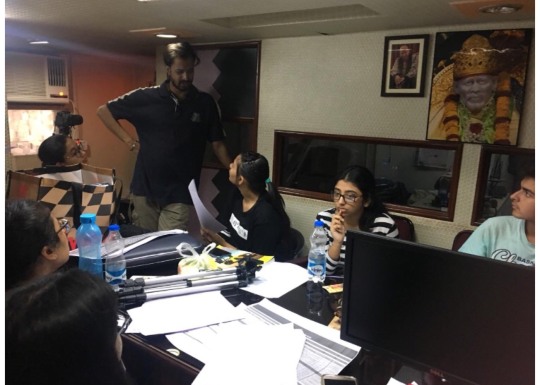
During the shoot, I did not have to create the look as the set was of a factory. At the current location I was responsible for the actors; Costumes, hairstyle, makeup, set outlook and preparing the actors well with their dialogues. I took charge with taking behind the scene stills, though it was the responsibility of Tanya. However, I enjoyed taking stills and found myself to have improved my photography.
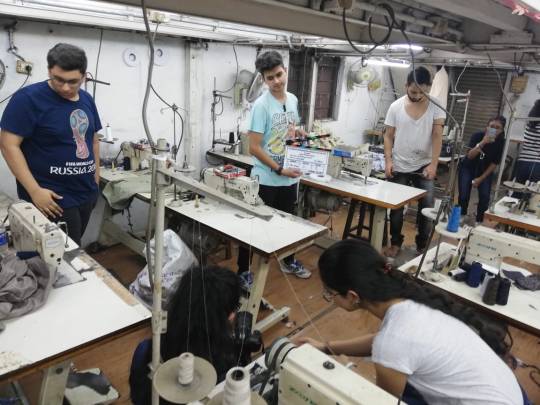
A particular still I took of Keyosha and Janhavi received much appreciation and I am glad as I had steady hands and was able to capture and frame correctly.
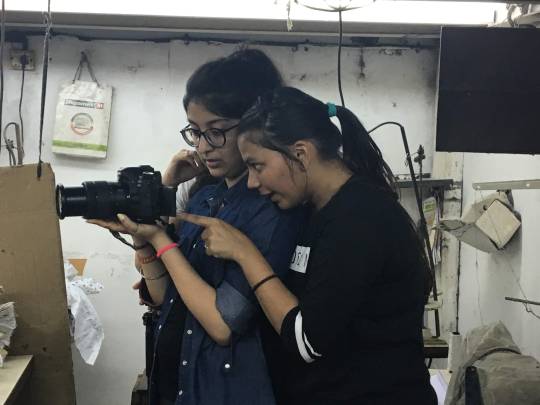
I began with work on the actor playing Ahmed, started off with a light foundation fit for the camera reflection, then oiling and combing his hair to give the look of obedience. I progressed ahead to apply black grease on his vest to make it look old and dirty to show him tired and ending the day’s work here. We had a few scenes showing Ahmed scared and tired, the sweat was shown through water from the spray bottle. When I started to spray, I sprayed without being cautious of the eyes however was guided by sir about the importance of being careful. With these sweating scenes, I stayed very vigilant about the continuity.
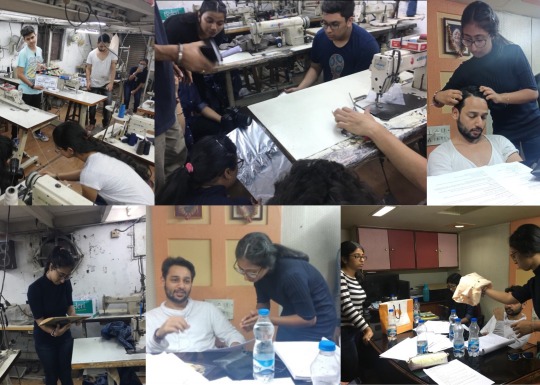
However in the shots with the manager, sir brought my attention towards an error from my side, wherein shirt glitches were visible on camera from the manager’s checked shirt but as this was at the very last moment we made no further changes. This is when I realised during manager’s look-test we had the actor wearing a different shirt, though this is a lesson for me to be more observant during look tests to avoid such mistakes.
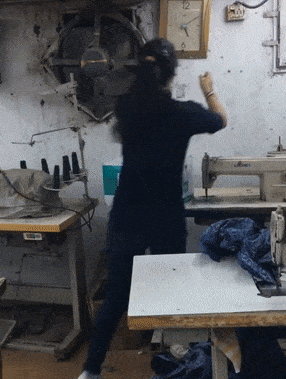
We finished shooting inside the machine room and went towards the next interior, the pathway which leads to the staircase. It was important to create and spooky effect of the pathway and as a production designer I had to look into visualising the scene and decide how the gelatin should be used,I with the help of my sir, Keyosha, Paarth and Tanya worked on covering the white tube lights with blue, yellow and red gelatin paper creating a spooky atmosphere. We implied colour symbolization again through these certain gelatin papers and avoided colours which show positivism and contradiction to the shot.
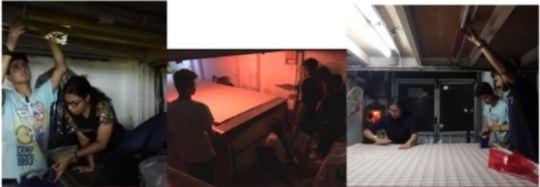
As this the light flickering set up dealt with electricity we had taken saftey measures by having adults around to help and ourselves being very careful to avoid any mishap.
Set design;
Sewing machine,
wooden tables and stools,
cloth and clothes,
thread,
buttons,
tape,
fans,
lights,
power supply,
exhaust fan,
staircase,
cabin door

Properties;
Tool kit,
Phone,
Taveez,
Earphone,
Matchbox,
Beeri (thin leaf cigarettes used by people of India)
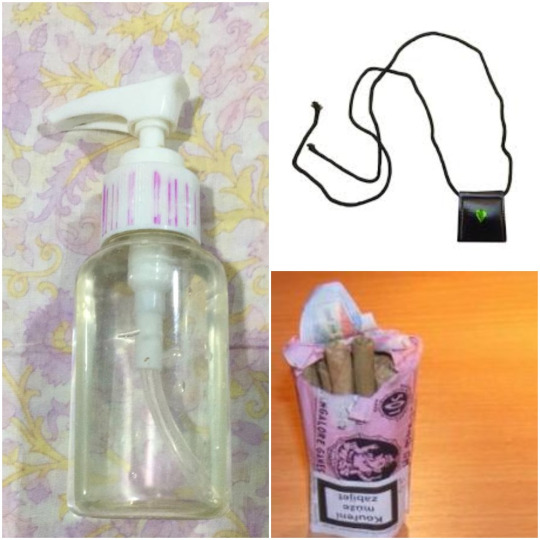
Production;
Fire extinguisher and medical kit,
Clock,
Sweat spray bottle,
Reflectors,
Extra light sources(emergency),
Gelatin paper,
Back grease,
Hair oil,
Clear tape and scissors,
Makeup brushes and foundation,
Hair comb,
Water and food requirements for cast & crew
As a reflection, I realised to be patient, keep calm even when things do not go as planned plus to always have an achievable backup. We had an actor of ours arrive late, which had built tension but never the less it’s great to have such an amazing teacher and assistant team who kept my team from not panicking. Simply because panicky situations mostly lead to bad results. Yet our shoot went really well and hoping the final outcome is great too.
0 notes
Text
Pochampalli Handloom Park
Things are going well. Hyderabad is a beautifully vibrant and raw city. India on the whole is so different from most things I've experienced that I'm still trying to get my head around it. My mind is still somewhat scattered, but I am gradually settling in with the group and the university life.
Yesterday Libby, Mae and I visited Pochampalli, a small village in the neighboring state of Andrhra Pradesh. I live in the state of Telangana, which was awarded separate statehood from Andrah Pradesh in June 2014. Although Hyderabad is officially in Telangana, it will serves as the joint capital city of Andhra Pradesh and Telangana for the next ten years.
We had little idea of what to expect from Pochampalli - Libby’s friend had recommended we visit the village off hand. Two hours and a multiple stops for directions later, we reached a small village tucked away in the rice paddies. Women squatted on their porches peeling vegetables while little boys drummed tin-pots. Goats wandered the dirt road, setting the seemingly tranquil pace of Pochampalli life, only disturbed by the occasional moped carrying a family of 4, speeding through the village. A group of tightly gathered people threw flower-pedals, slowly making their way to the nearby graveyard to bury a loved one.
Eventually we reached the Handloom Park. A number of the village people, primarily women, are employed by the factory when agriculture is not in season. We asked to tour the factory, to which the owner agreed to with an eager Indian head-bob. I am learning to head-bob along, but I am everything but smooth and am embarrassingly often left feeling more dizzy than integrated.
A girl named Sanja, who was accompanied by her parents, joined us on the tour. Sanja is from Hyderabad and is in her first year of university to study Product Design. She had come to the Handloom Park to film a documentary for school, in which I am fairly certain we will be starring! Sanja’s parents knew a surprising amount about Vikings and we ended up discussing Norse mythology as we waited for our tour to begin.
A while later, the owner introduced us to a man he referred to as ‘The Master’. The Master had a kind demeanor, a thick mustache, wide eyes and was dressed in all white. He smiled and blurted something out in Hindi before leading us to the factory. The intricate factory process can be roughly divided into three main stages. First cotton and silk are spun into unbelievably fine thread; next, the thread is dyed, sometimes mono-color, sometimes in patterns; and eventually the thread is set up on a loom where it is made into fabric.
The Master showed us a number of types of looms, including one that Ghandi was keen to use. Sanja’s dad told me that before the mechanization and mass-production that followed British colonization in 1858, a six meter sari would be produced so fine it could fit into a matchbox.
Despite being post-colonization, the fabric produced was very beautiful, or “bahut khoobasoorat”, as I learnt to say in Hindi. When we got back to the shop, I decided to buy a shirt that I could wear back home - a men’s shirt admittedly, which the women laughed at. Who was this white, bald lady trying on men’s shirts? We were quite the attraction and naturally posed for photos with several curious handloom workers.
The sky had turned a gentle pink when we headed back to the car. People were slowly making their way to the temple as the Hindu call to prayer echoed all around us. We had missed dinner, so on our way back home we stopped for delicious street dumplings at Momo’s. My stomach did not react well the next day, but I have no regrets! Tomorrow we start class. I looking forward checking out British Romantic Literature and Development and Disaster.
0 notes